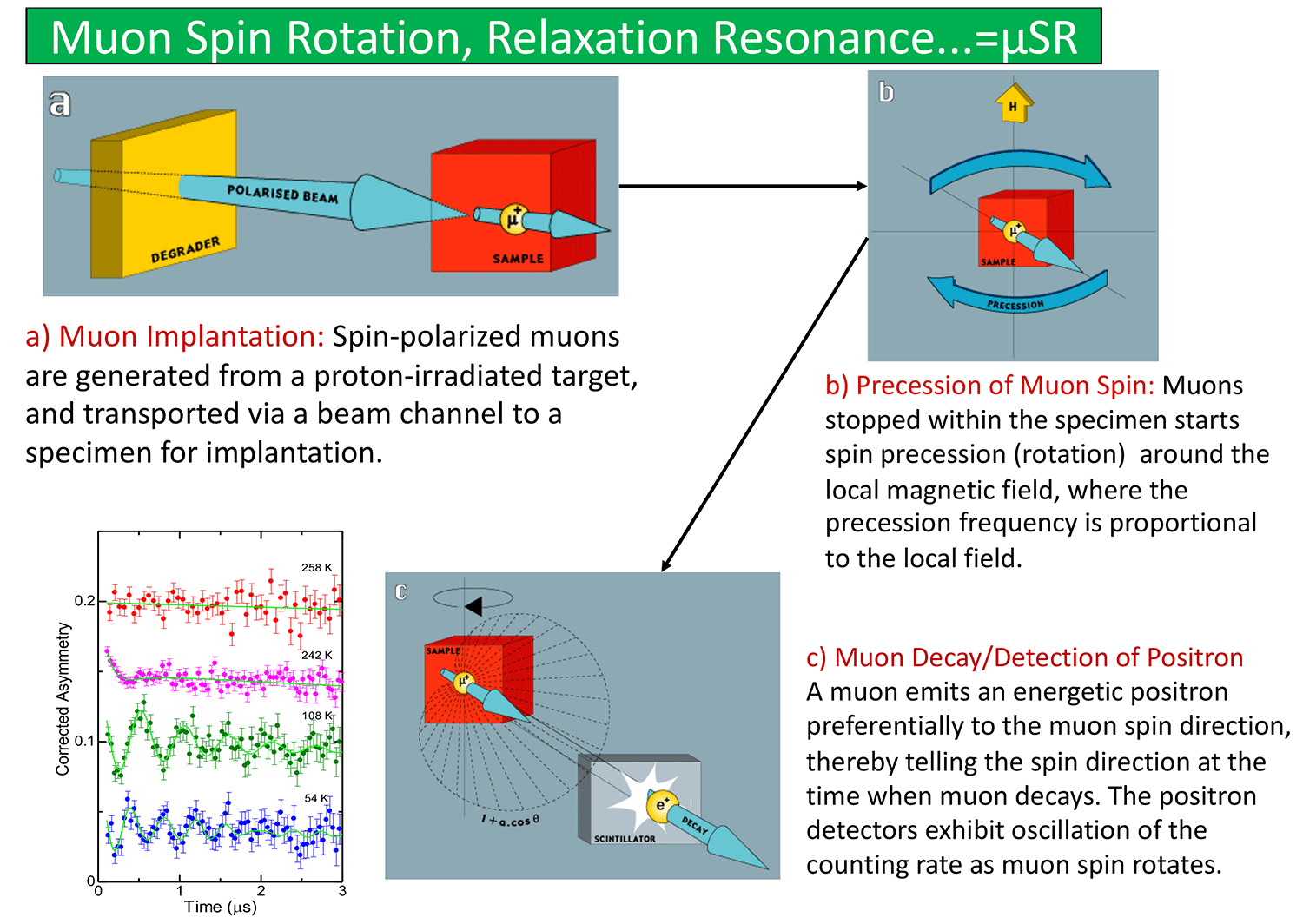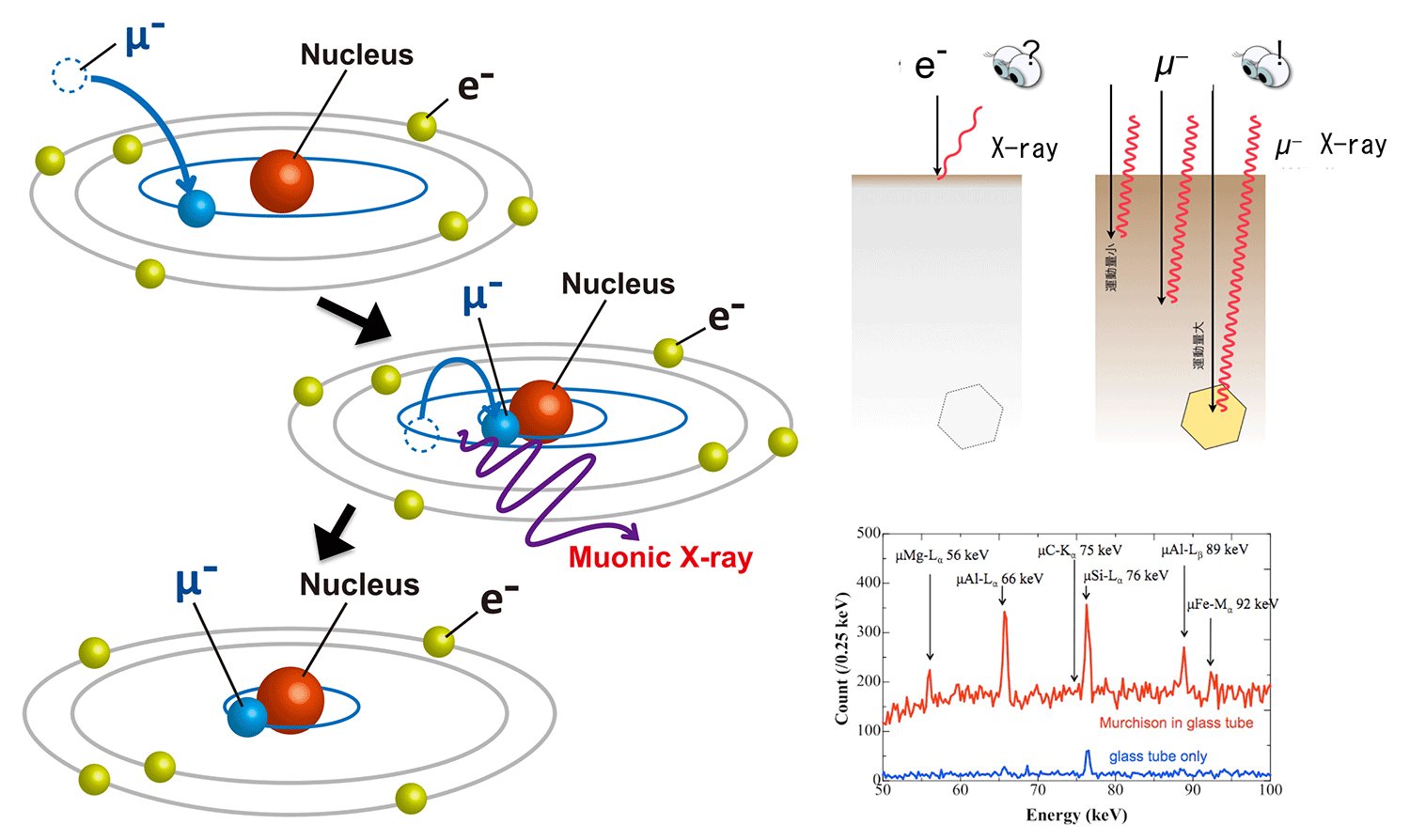Muon experiment
Muons (mu particle, expressed by the Greek letter µ) are elementary particles formed as a result of the rapid decay of pions (pi mesons, π), which themselves are produced by collisions between high-energy proton beams and carbon nuclei in the graphite target. Muons have either a positive or negative unit electric charge (expressed as µ+ or µ-) and a low mass—approximately one-ninth that of a proton. They have a mean lifetime of approximately 2.2 µs, subsequently decaying into either a positron (for µ+) or an electron (for µ-) and two neutrinos. Because of its mass and charge, the positively-charged muon acts as a lightweight radioactive isotope of proton (pseudo-hydrogen) in matter. Upon implantation into samples, muons find a stable position among constituent atoms (e.g., interstitial sites near negative ions in crystalline solids) almost immediately (<1 ns), and their muon spin (quantum-mechanical self-rotation) direction exhibits precession motion (i.e., the Larmor precession) with frequencies proportional to the magnetic field at their respective positions until their decay.
Meanwhile, negatively-charged muons act as heavy electrons in matter (as they have approximately 206 times the mass of a normal electron). They are captured in an atomic bound state almost instantaneously (~ 1 ns) with the positively charged nuclei, which is referred to as “muonic atoms.” The capture process accompanies emission of distinct element-specific X-rays during the interorbital transitions of a negative muon to the ground state orbiting around a nucleus. The orbiting muons finally disappear either by the natural decay or capture by the nucleus. The nuclear capture rate becomes greater with increasing nuclear size (which is larger for the greater atomic number), leading to the shorter effective lifetime of negative muons accordingly.
In these ways, muons exhibit distinct and unique characters in substances depending on their electric charge, which are utilized in muon experiments for materials research being conducted at D1/D2 and S1 instruments.
Moreover, the muon is expected to provide important clues to the new physics beyond the Standard Model in the field of particle physics, for which the H line is under construction to host a variety of experimental studies.
Muon target
The muon production target is located about 30 m upstream of the neutron target. The target is made of a 2-cm-thick graphite wheel, and consumes about 5% of the incident proton beam to generate high-flux pions (for decay-in-flight muons) and surface muons. The corresponding beam loss is 50 kW under 1-MW operation, and thus the countermeasure is essential against the heat deposit and the radiation damage on the target itself and the surrounding devices.
The wheel-shaped rotating disk was adopted to mitigate the radiation damage by dispersing proton irradiation along the circumference. In addition, the development of a rad-hard bearing system was the key to reliable operation. To this end, inorganic solid lubricant (WS2) was introduced to solve the problem expected under high radiation field.
Currently, the muon facility operation and maintenance are supported by continuous R&Ds for improving reliability and safety of the target system.
Muon beamlines
The muon production target is surrounded by four muon beamlines (the D, U, S, and H lines) extending to two experimental halls. The D line is located in the hall No. 2. It has a modest acceptance for collecting pions, and furnished with a 6-m solenoid as a decay-in-flight section though which muons of various kinetic energies are provided to D1 and D2 instruments installed in the corresponding experimental areas. The U line is adjacent to the D line, consisting only of axial focusing magnets, namely a large-acceptance rad-hard capture solenoid, a superconducting curved transport solenoid, and superconducting axial focusing magnets. These magnets are for transporting a high-flux surface muons from which an “ultra-slow muon” (USM) beam is generated in the end. In the experimental hall No. 1, the S line that is dedicated for surface muon beams is planned to have four branches and associated experimental areas (S1–S4). At present, a branch to the S1 area has been completed in 2016 to provide surface muons to the ARTEMIS spectrometer. The H line is under construction toward the first beam delivery in 2021.
Substance / material research using positive muons
The muons derived from accelerator-generated pions exhibit the characteristic that their spins are aligned in the beam direction (i.e., highly spin-polarized) without applying any external magnetic field (which is needed to induce polarization for other magnetic resonance methods using atomic nuclei or electrons). This, combined with another useful property that the energetic positrons are preferentially emitted along the muon spin direction upon their decay, is a considerable advantage in that we can study the time evolution of muon spins within the substance by observing the space-time distribution of emitted positrons. Since the spin precession frequencies are proportional to the local magnetic fields at the respective muon sites, implanted muons can be used as a "magnetic probe" inside the substance. This method is referred to as muon spin rotation/relaxation/resonance (µSR).

µSR is complementary to other methods based on diffraction/scattering, as it does not need long-range coherence of magnetic structure. It is also characterized by the unique time window of microseconds for studying the time-dependent phenomena in magnetism. Furthermore, as previously mentioned, positive muons simulate various electronic states of hydrogen by acting as a lightweight proton isotope when inside a substance, thus providing a unique method for investigating the roles of trace quantities of hydrogen in a target substance.
Non-destructive elemental analysis using negative muons
The necessity of investigating the constituent elements and compositions of samples without damaging them, ranging from archaeological objects to living plants and animals, is widespread across the scientific disciplines. Fluorescent X-ray analysis is one of the most popular methods to achieve this; it measures the characteristic X-rays emitted when the atoms excited by the incident X-rays in the sample return to lower energy states. However, this technique has disadvantages in that it has poor sensitivity for elements lighter than sodium, and that even among the detectable elements, the information only near the surface can be obtained, because of the relatively low energy of characteristic X-rays that limits the thickness for the X-rays to penetrate. This is where non-destructive elemental analysis using characteristic X-rays accompanied by negative muon capture (called muonic X-rays) can be implemented.

The muonic X-rays are 206 times higher in energy than the fluorescent X-rays due to the muon's larger mass; at these high energies, the muonic X-rays can reach the detector after penetrating material thicknesses from several mm to cm, and elemental analyses of the sample interior can be performed using energetic negative muons implanted deep within the samples. While this method is not suitable for the analysis of large immovable objects because it requires accelerator-based beams, it has a merit that activation of the sample material is negligible for lighter elements due to the natural decay of the negative muon. Thus this method is expected to serve as a non-destructive elemental analysis method that can facilitate the analysis of all elements including those with lighter mass.